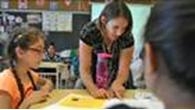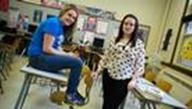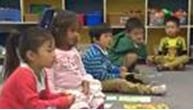Kids with learning disabilities can turn things around
DIANE PETERS
Special to The Globe and Mail
By the time her daughter, Ray, was in Grade 3, Blair Jurecka knew she needed more than the public school system had to offer. Ray could read, but was not up to grade level and was falling behind in every other subject. She relied on her best friend to know what was going on in class. Her confidence was shot.
More Related to this Story
• Private Schools: Trilingualism Immersion goes beyond French
• Private Schools: Careers It’s never too early to consider a line of work
• Private Schools: Primer The ABCs of private education
Video
Video: Should we pay teachers based on test scores?
Video
Video: Student aid: How a friend can make all the difference
Video
Video: Study shows that full-day kindergarten is better for kids
Ray’s west-end Toronto public school tested her and discovered gifted-level intelligence, but also found language-related learning disability. The report was difficult to understand but soon the family realized Ray had dyslexia. The school offered extra support, but it wasn't enough to help Ray get back to grade level.
Ms. Jurecka enrolled her daughter in the University of Toronto’s Institute of Child Study, a private school that offered some extra support, which helped a little.
Then Ray’s grandmother, a speech pathologist, heard educator Evelyn Reiss speak at a conference about the Orton-Gillingham approach, a style of teaching that breaks language down very systematically. “We have to try this,” she told the family.
Ms. Jurecka hired Ms. Reiss as a tutor and Ray’s average went up three grade points the year she was in Grade 6.
The following year, Ms. Reiss opened a school called Claremont School and Ray enrolled, with her grandparents helping out with the $14,000 tuition. For two years, Ms. Jurecka, an architect, worked her schedule around driving her daughter across town to attend the school, which is located in rented rooms in an east-end church.
Last fall, Ray entererd a public high school and ended up on the honour roll. She has an individualized education program to accommodate her learning disability, but the school rarely needs to follow it. “Ray approaches learning in such a good way. She has all the tools,” Ms. Jurecka says.
Claremont and other schools focused on learning disabilities offer a leg up to students who need it badly. These children are struggling in school both academically and socially. Even parents who can’t readily afford the tuition are digging deep to take advantage of cutting-edge teaching techniques, small class sizes and a more positive environment.
There’s demand, despite high prices. When Ms. Reiss opened her school for children from grades 1 through 10 in 2010, she landed her first students through word of mouth. While just in its fourth school year, Claremont now has 34 full-day students – plus more that come for special education during the day and tutoring at night. Ms. Reiss has gone from a two-classroom operation to running seven classrooms and an office – all the church has left to rent her.
Like Claremont, Vancouver-based Eaton Educational Group, which runs three full-time schools for children from kindergarten to Grade 12 and two adult learning centres in British Columbia, focuses teaching around a philosophy that it is possible to treat learning disabilities by identifying and strengthening cognitive capacities. Eaton, as well as the Arrowsmith schools in Toronto and Peterborough, Ont., all base their curriculum around theory that the brain can change if you stimulate it, and that children with learning disabilities can get to the root of their problems by strengthening certain brain skills.
“We do a lot of assessments, we interview the children and the families. We narrow down what they need and we individualize a program for them,” says Sandra Heusel, Eaton’s communications director. The program identifies 19 learning areas and individual programs involve brain exercises to work on those areas that aren’t up to par.
At $28,000 a year, Eaton’s tuition is hefty. “A number are taking out second mortgages on their home or are moving back with their parents,” Ms. Heusel says. But the goal at Eaton is to retrain the brain so that after three or four years the student is ready to go back into the public school system. Many return without a need for accommodation.
At the Foothills Academy, a 34-year-old school in Calgary with 225 students, individual attention is how the school defines itself. There are 12 to 14 students a class, and teachers know each student and his or her learning challenge.
“Most of the time, teachers will make up new ways to help the student,” says Simon Williams, program co-ordinator at the school. “We do have set programs to boost math and writing, but the key to success is the individual attention for each and every kid’s needs.”
Foothills also makes a point of dealing with the social side of a learning disability. “A lot of them have trouble with social skills. All our kids have experienced failure, so their self esteem is low, their motivation is low,” Mr. Williams says.
The school maintains a “wall of fame” that’s constantly updated with the names of children who have bumped up their work in English, math and other subjects.
Unlike in a public school, children in these schools don’t stand out for needing extra help. They’ve all been through similar challenges, and since the schools are small, students and teachers develop a real closeness. “It feels like a family here,” Ms. Reiss says of Claremont. “The students are valued.”
Extracurricular activities, while not as plentiful as in public schools, are carefully geared to bolster self esteem and make the once-arduous chore of being at school seem fun. Foothills runs sports, drama clubs and camping trips. Claremont teaches children drumming and performs plays; everyone helps out with a lunch for the homeless once a week.
Many of these schools have limits on who they will take. Children with serious behavioural problems are often not accepted. Some, such as Foothills, make a point of teaching up to grade level and graduate children into university and college admission. Others, such as Eaton, work on the learning problem and expect children to catch up later in the public system.
It’s all about fit: The learning style, cost and even location have to work out for families to invest. But many do, to give their child a chance to feel successful and possibly avert a lifetime of of learning difficulties and self-esteem problems. Says Ms. Jurecka of her daughter’s time at a private school, despite the costs: “It was 100-per-cent worth it. All the families at the school have seen such an amazing difference in their kids. It makes me feel all choked up every time I think about it.”
แสดงความคิดเห็น
รายละเอียดกระทู้
DIANE PETERS Special to The Globe and Mail http://www.theglobeandmail.com/news/national/education/kids-with-learning-disabilities-can-turn-things-around/article14530905/ By the time her daughter, Ray, was in Grade 3, Blair Jurecka knew she needed more than the public school system had to offer. Ray could read, but was not up to grade level and was falling behind in every other subject. She relied on her best friend to know what was going on in class. Her confidence was shot. More Related to this Story • Private Schools: Trilingualism Immersion goes beyond French • Private Schools: Careers It’s never too early to consider a line of work • Private Schools: Primer The ABCs of private education Video: Should we pay teachers based on test scores? Video Video: Should we pay teachers based on test scores? http://www.theglobeandmail.com/news/news-video/video-should-we-pay-teachers-based-on-test-scores/article14199085/ Video: Student aid: How a friend can make all the difference Video Video: Student aid: How a friend can make all the difference http://www.theglobeandmail.com/video/20130611theglobeandmail-linkbully-crystalcarlyv1-720pmp4/article12470375/ Video: Study shows that full-day kindergarten is better for kids Video Video: Study shows that full-day kindergarten is better for kids http://www.theglobeandmail.com/life/parenting/back-to-school/video-study-shows-that-full-day-kindergarten-is-better-for-kids/article14084096/ Ray’s west-end Toronto public school tested her and discovered gifted-level intelligence, but also found language-related learning disability. The report was difficult to understand but soon the family realized Ray had dyslexia. The school offered extra support, but it wasn't enough to help Ray get back to grade level. Ms. Jurecka enrolled her daughter in the University of Toronto’s Institute of Child Study, a private school that offered some extra support, which helped a little. Then Ray’s grandmother, a speech pathologist, heard educator Evelyn Reiss speak at a conference about the Orton-Gillingham approach, a style of teaching that breaks language down very systematically. “We have to try this,” she told the family. Ms. Jurecka hired Ms. Reiss as a tutor and Ray’s average went up three grade points the year she was in Grade 6. The following year, Ms. Reiss opened a school called Claremont School and Ray enrolled, with her grandparents helping out with the $14,000 tuition. For two years, Ms. Jurecka, an architect, worked her schedule around driving her daughter across town to attend the school, which is located in rented rooms in an east-end church. Last fall, Ray entererd a public high school and ended up on the honour roll. She has an individualized education program to accommodate her learning disability, but the school rarely needs to follow it. “Ray approaches learning in such a good way. She has all the tools,” Ms. Jurecka says. Claremont and other schools focused on learning disabilities offer a leg up to students who need it badly. These children are struggling in school both academically and socially. Even parents who can’t readily afford the tuition are digging deep to take advantage of cutting-edge teaching techniques, small class sizes and a more positive environment. There’s demand, despite high prices. When Ms. Reiss opened her school for children from grades 1 through 10 in 2010, she landed her first students through word of mouth. While just in its fourth school year, Claremont now has 34 full-day students – plus more that come for special education during the day and tutoring at night. Ms. Reiss has gone from a two-classroom operation to running seven classrooms and an office – all the church has left to rent her. Like Claremont, Vancouver-based Eaton Educational Group, which runs three full-time schools for children from kindergarten to Grade 12 and two adult learning centres in British Columbia, focuses teaching around a philosophy that it is possible to treat learning disabilities by identifying and strengthening cognitive capacities. Eaton, as well as the Arrowsmith schools in Toronto and Peterborough, Ont., all base their curriculum around theory that the brain can change if you stimulate it, and that children with learning disabilities can get to the root of their problems by strengthening certain brain skills. “We do a lot of assessments, we interview the children and the families. We narrow down what they need and we individualize a program for them,” says Sandra Heusel, Eaton’s communications director. The program identifies 19 learning areas and individual programs involve brain exercises to work on those areas that aren’t up to par. At $28,000 a year, Eaton’s tuition is hefty. “A number are taking out second mortgages on their home or are moving back with their parents,” Ms. Heusel says. But the goal at Eaton is to retrain the brain so that after three or four years the student is ready to go back into the public school system. Many return without a need for accommodation. At the Foothills Academy, a 34-year-old school in Calgary with 225 students, individual attention is how the school defines itself. There are 12 to 14 students a class, and teachers know each student and his or her learning challenge. “Most of the time, teachers will make up new ways to help the student,” says Simon Williams, program co-ordinator at the school. “We do have set programs to boost math and writing, but the key to success is the individual attention for each and every kid’s needs.” Foothills also makes a point of dealing with the social side of a learning disability. “A lot of them have trouble with social skills. All our kids have experienced failure, so their self esteem is low, their motivation is low,” Mr. Williams says. The school maintains a “wall of fame” that’s constantly updated with the names of children who have bumped up their work in English, math and other subjects. Unlike in a public school, children in these schools don’t stand out for needing extra help. They’ve all been through similar challenges, and since the schools are small, students and teachers develop a real closeness. “It feels like a family here,” Ms. Reiss says of Claremont. “The students are valued.” Extracurricular activities, while not as plentiful as in public schools, are carefully geared to bolster self esteem and make the once-arduous chore of being at school seem fun. Foothills runs sports, drama clubs and camping trips. Claremont teaches children drumming and performs plays; everyone helps out with a lunch for the homeless once a week. Many of these schools have limits on who they will take. Children with serious behavioural problems are often not accepted. Some, such as Foothills, make a point of teaching up to grade level and graduate children into university and college admission. Others, such as Eaton, work on the learning problem and expect children to catch up later in the public system. It’s all about fit: The learning style, cost and even location have to work out for families to invest. But many do, to give their child a chance to feel successful and possibly avert a lifetime of of learning difficulties and self-esteem problems. Says Ms. Jurecka of her daughter’s time at a private school, despite the costs: “It was 100-per-cent worth it. All the families at the school have seen such an amazing difference in their kids. It makes me feel all choked up every time I think about it.”
จัดฟอร์แม็ตข้อความและมัลติมีเดีย
รายละเอียดการใส่ ลิงค์ รูปภาพ วิดีโอ เพลง (Soundcloud)





